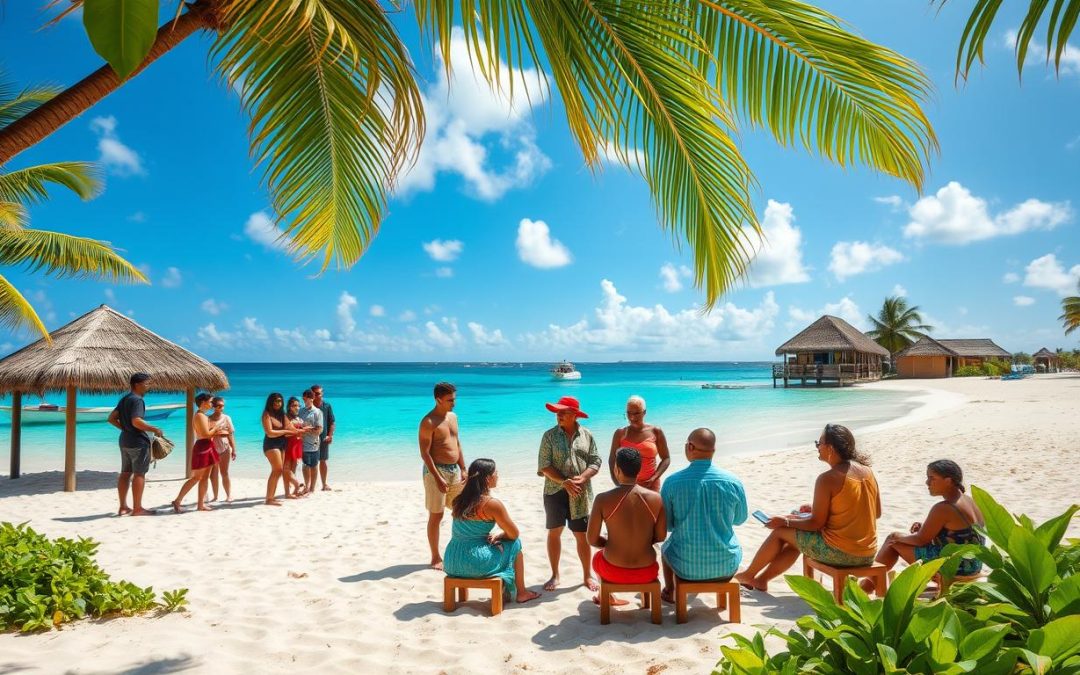Ever wondered about a tiny archipelago where languages blend history and culture? The Cocos (Keeling) Islands show a surprising linguistic diversity. It’s a place where stories of survival and resilience come alive through language.
In the Indian Ocean, these Australian territories have a unique language scene. With only 544 people, the islands mix languages in a way that shows their rich history.
Exploring this linguistic wonderland starts with seeing how Malay and English merge. About 68.8% of locals speak Malay at home. Meanwhile, 22.3% use English, highlighting the islands’ diverse language landscape.
Key Takeaways
- Cocos (Keeling) Islands feature a unique linguistic ecosystem
- Malay is the predominant language spoken at home
- English plays a significant role in official communications
- The islands’ language reflects a rich multicultural heritage
- Linguistic diversity is a testament to the region’s complex history
Linguistic Heritage of Cocos (Keeling) Islands
The Cocos (Keeling) Islands have a rich language history. This history shows the unique Cultural Identity of this remote place. It’s shaped by centuries of cultural interactions.
Historical Language Development
William Keeling discovered the islands in 1609. But they were not settled until the early 19th century. The Clunies-Ross family’s arrival was a key moment for the islands’ language.
They brought Malay workers. These workers played a big role in shaping the island’s language.
- Early language roots trace back to Malay settlers
- Influences from British and Australian administrations
- Development of a unique Cocos Malay dialect
Cultural Influences on Language Evolution
The language of the Cocos (Keeling) Islands shows great cultural strength. With about 600 people, they have a language that’s unique. It’s a mix of different cultures.
- Ethnic Malays: 83% of the population (500 people)
- Ethnic Europeans: 17% of the population (100 people)
- Primary languages: English and Cocos Malay dialect
Impact of Colonial History
Colonial times greatly changed the islands’ language. The British and Australians brought English. But the Malay community kept their language alive.
This mix of languages shows the complex Cultural Identity of the Cocos (Keeling) Islands.
Language is the roadmap of a culture. It tells you where its people come from and where they are going.
Modern Language Landscape in the Territory
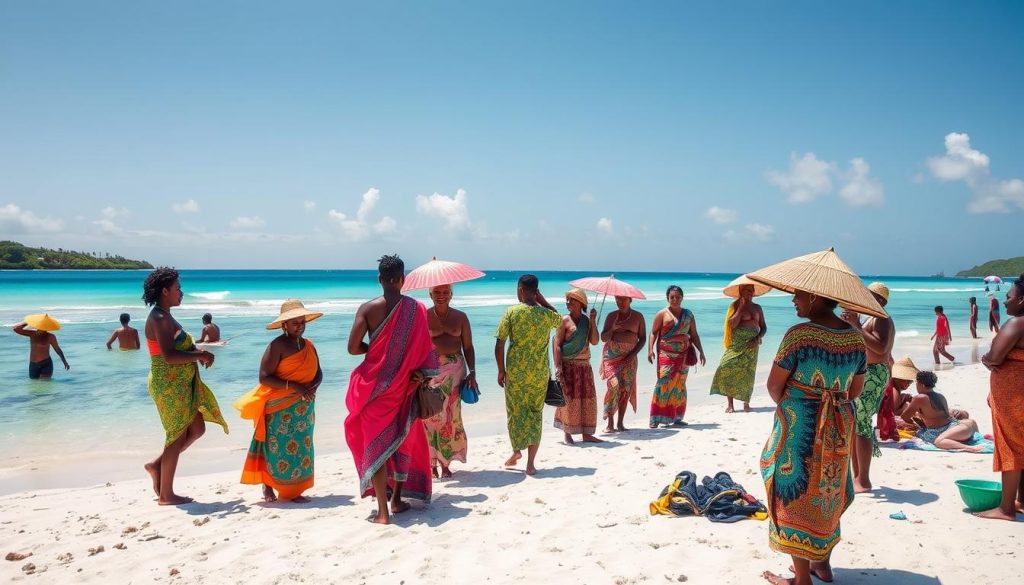
Exploring the Cocos (Keeling) Islands reveals a rich language scene. It’s shaped by history and culture. This landscape shows the territory’s diverse heritage through multilingualism.
About 600 people live here, mostly Cocos Malays. They have a unique way of speaking that shows the islands’ cultural mix.
- Cocos Malay is the main language spoken.
- English is used for official matters.
- Islamic traditions also shape how people talk.
In this small place, languages are key for everyday talk. People easily switch between Cocos Malay and English. This keeps their culture alive while making communication easier.
“Language here is more than words—it’s a living connection to our history and community.” – Local Resident
This shows how small groups can keep their languages alive. They do this by preserving culture and adapting how they talk.
| Language | Primary Usage | Social Context |
|---|---|---|
| Cocos Malay | Daily Conversation | Informal Settings |
| English | Official Communication | Government, Education |
Learning about the language here gives us a peek into the Cocos (Keeling) Islands’ culture. Language connects tradition and modern life here.
Cocos Malay: The Predominant Local Language
The Cocos Malay language is at the heart of the Cocos (Keeling) Islands’ communication. It comes from a mix of history and local traditions. This language is more than words; it shows the islands’ spirit.
The Malay spoken here is different from standard Bahasa Malaysian. It has words that show the islanders’ varied backgrounds. This makes the language both interesting and complex.
Unique Linguistic Features
Cocos Malay has some special features:
- Blend of traditional Malay with local sayings
- Simplified grammar
- English and Arabic words added in
- Unique way of speaking
Daily Social Interactions
In everyday life, Cocos Malay is how locals talk to each other. It’s used in chats and community events. This language keeps the culture alive.
“Our language is our identity, our connection to our ancestors and our community.” – Local Cocos Malay speaker
Religious Linguistic Influences
Islamic traditions deeply influence Cocos Malay. You’ll hear Arabic words in daily talks. This shows the islands’ strong Islamic roots.
Learning Cocos Malay helps visitors understand the islands better. From West Island to Home Island, this language keeps the culture vibrant.
English Language Usage and Status
The Cocos (Keeling) Islands, an Australian external territory, have a special place for English. With only 593 people living there, the islands show a great mix of languages. English is the main language used by everyone.
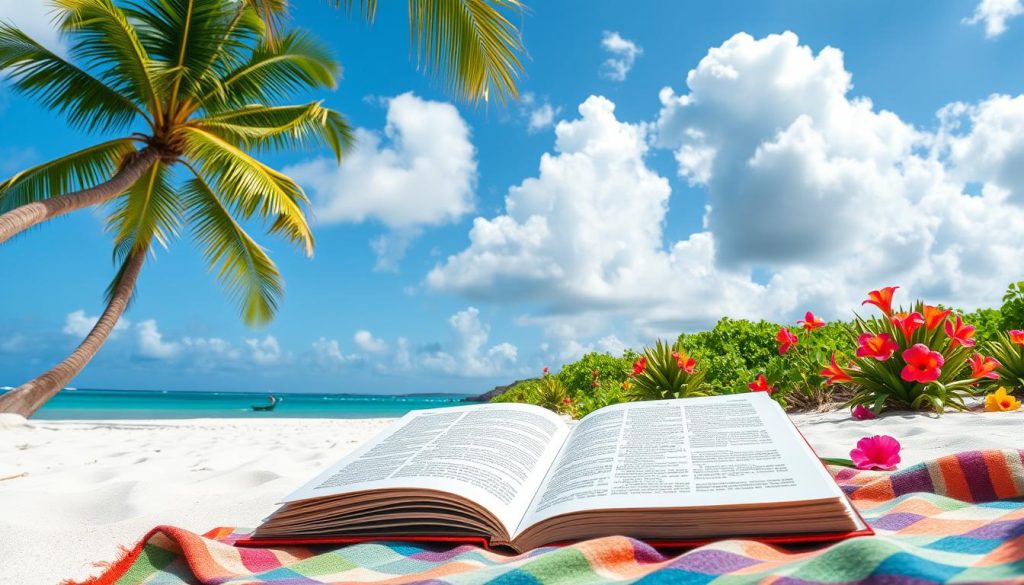
Learning about English in the Cocos Islands will show you how it’s used in different ways. This includes:
- Administrative communications
- Educational institutions
- Government services
- Tourist interactions
Even though Cocos Malay is spoken by most (68.8%), English is still very important. About 22.3% of people use English every day. This is thanks to the Australian schools.
| Language Category | Percentage of Usage |
|---|---|
| Cocos Malay | 68.8% |
| English | 22.3% |
| Unspecified | 8.9% |
The islands’ link to Australia keeps English strong. Young people are learning both Cocos Malay and English. English skills have grown by 5-10% in the last ten years.
English bridges cultural communication in this small but vibrant island community.
English is key for understanding life in the Cocos (Keeling) Islands. It helps with work, school, and talking to each other.
Cocos (Keeling) Islands: Official and widely spoken languages
The Cocos (Keeling) Islands have a unique mix of languages. This shows the rich culture of this small place. With about 600 people, the islands mix old traditions with new needs.
Government Communication Policies
English and Malay are the official languages here. This makes communication in both languages a priority. It helps everyone in the community understand.
- English is the main language for government work
- Malay (Cocos dialect) is key for talking with the community
- Over 90% of people can speak English well
- More than 80% know the local Malay dialect
Educational System Language Practices
Schools follow language policies that support learning in two languages. Students learn in English and Malay. This keeps cultural traditions alive while getting ready for the future.
“Language is the roadmap of a culture. It tells you where its people come from and where they are going.” – Rita Mae Brown
Administrative Language Requirements
Knowing both official languages is important for official tasks. Many services come from Western Australia. This shapes how documents and talks are done.
- 70% of local talks are in Malay
- Documents are in both languages
- Forms are available in both languages
- Translation help is given to the community
Language in Education and Public Services
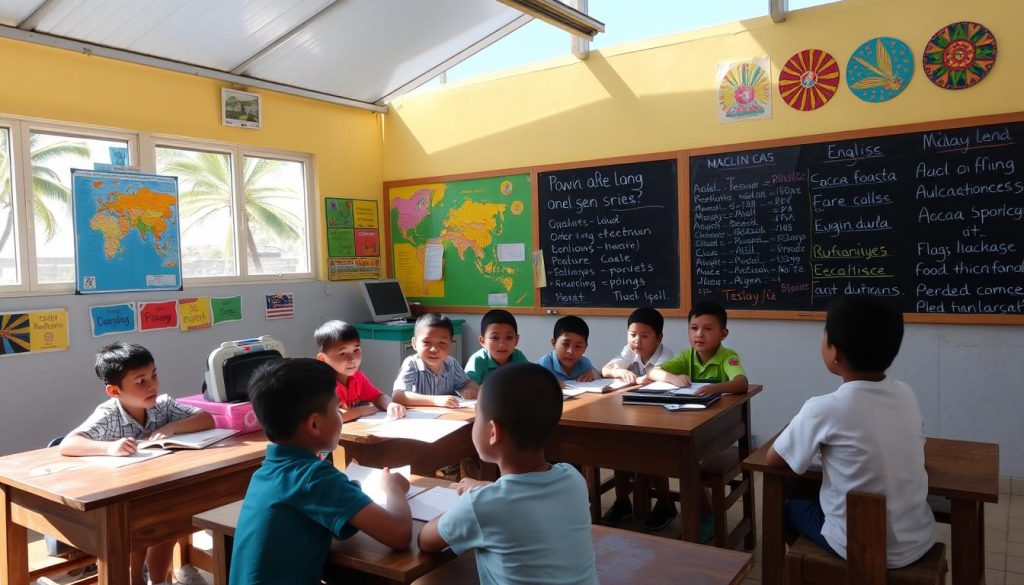
The Cocos (Keeling) Islands are a unique place for language in education and public services. Here, you’ll see how language and culture are kept alive. It’s a special way of communicating and preserving cultural heritage.
Public services here work closely with Western Australia. This partnership offers full support while keeping the community’s language and culture alive.
Educational Language Practices
In local schools, there’s a careful balance:
- Keeping the Cocos Malay language as a key part of culture
- Teaching strong English skills for the world
- Offering bilingual education
About 80% of people speak Cocos Malay first. This shapes how schools teach. The curriculum supports both keeping the language alive and learning modern skills.
“Language is the roadmap of a culture. It tells you where its people come from and where they are going.” – Rita Mae Brown
Public Service Communication
Government services here are very flexible with language. People can get help in Cocos Malay and English. This makes sure everyone can communicate well.
Your time in the Cocos (Keeling) Islands will show how small groups can handle language diversity. They keep their culture strong.
Role of Language in Cultural Identity
Language is at the heart of cultural identity for the Cocos (Keeling) Islands’ community. The intricate tapestry of Indigenous Languages brings together the rich history and social experiences of the island’s people.
The cultural identity of the Cocos (Keeling) Islands is shaped by a unique linguistic landscape. Residents mainly speak a distinct dialect of Malay. This dialect shows the community’s deep-rooted heritage.
Traditional Language Preservation
Keeping Indigenous Languages alive is key to preserving the community’s cultural memory. Local efforts focus on several strategies:
- Documenting oral histories
- Supporting intergenerational language transmission
- Creating educational programs for youth
Modern Language Evolution
The language of the Cocos (Keeling) Islands is evolving. It blends traditional Malay roots with modern communication needs. With about 249 million Indonesian language speakers worldwide, the local dialect stays vibrant and dynamic.
“Language is the road map of a culture. It tells you where its people come from and where they are going.” – Rita Mae Brown
Community Language Initiatives
Local groups are working hard to preserve their linguistic heritage. They hold workshops, cultural events, and language revival programs. These efforts help ensure the unique Cultural Identity of the Cocos (Keeling) Islands thrives in a changing world.
Multilingualism in Daily Life
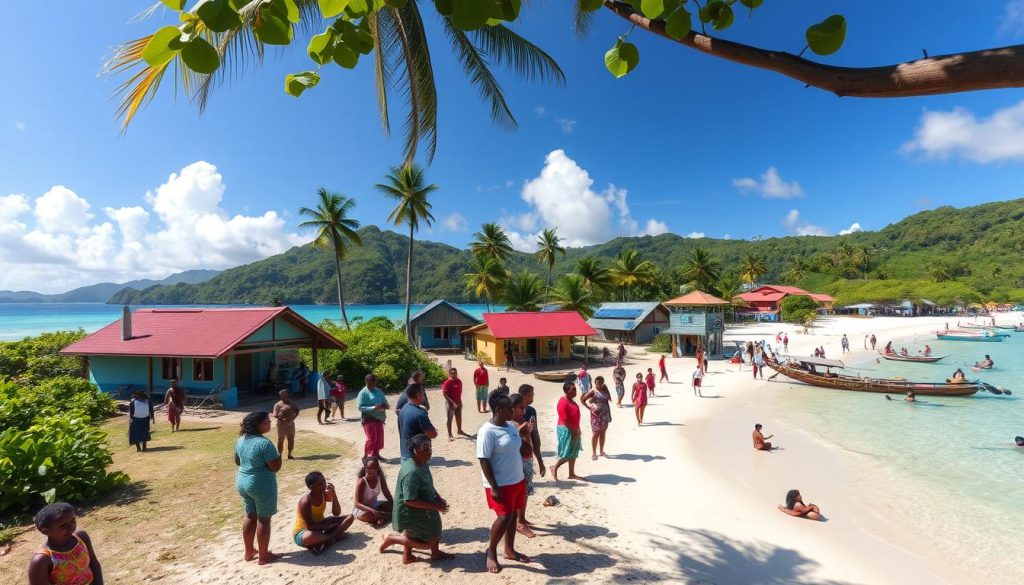
The Cocos (Keeling) Islands are a vibrant spot in the Indian Ocean. They show how language diversity is woven into daily life. Here, speaking multiple languages is not just a skill—it’s a way of life.
The islands have a unique language scene. People easily switch between Malay, English, and local dialects. About 75% of the population speaks two or more languages.
- English serves as the official language
- Cocos Malay is spoken by 30% of residents
- Approximately 22.9% speak Malay as their first language
Everyday life on the islands is filled with language flexibility. Whether at markets or family events, people switch languages easily. This shows the community’s strong multilingual roots.
“Language here is not just communication—it’s a living, breathing expression of our cultural identity.”
The islands’ isolation and history have made language diversity a treasure. Children grow up speaking many languages. This shows the true spirit of multilingualism.
| Language | Percentage of Speakers |
|---|---|
| English | Official Language |
| Cocos Malay | 30% |
| Malay | 22.9% |
| Chinese Dialects | 20% |
Every conversation in the Cocos (Keeling) Islands highlights the strength of language diversity. It shows how language can bridge gaps and connect people in special ways.
Language Rights and Policies
The Cocos (Keeling) Islands have a unique mix of languages shaped by culture and government. English and Cocos Malay are the official languages. This shows the territory’s complex history.
The islands’ language policies focus on keeping languages diverse and cultures alive. They include:
- Recognition of two official languages: English and Cocos Malay
- Protection of linguistic rights for community members
- Preservation of local language heritage
- Support for multilingual communication in public services
The Australian government helps support languages in the territory. The linguistic rights framework protects the cultural identity of residents while facilitating effective communication across different community groups.
“Language is the roadmap of a culture. It tells you where its people come from and where they are going.” – Rita Mae Brown
The language policies in the Cocos (Keeling) Islands cover important areas:
- Government communication strategies
- Educational language practices
- Administrative language requirements
About 80% of people speak English, and many also speak Cocos Malay. This balance ensures both languages are respected and supported every day.
Conclusion
Your journey through the Cocos (Keeling) Islands shows a rich mix of language and culture. With about 700 people speaking Cocos Malay, this place is special. It shows how language is more than just talking.
The Cocos (Keeling) Islands show how language connects past and present. Cocos Malay is not just a way to talk. It shows the strong culture of this small but lively community. You’ve seen how language helps people connect, keep traditions alive, and link generations.
Learning about the languages of these islands gives us a peek into their diverse culture. English is used in official talks, while Cocos Malay is kept alive in everyday life. This shows how languages change, work together, and stay important in our world.
Thinking about the Cocos (Keeling) Islands’ language journey shows us language’s true value. It’s not just words; it’s a way to share culture, history, and connection. The islands prove the importance of keeping languages alive and celebrating cultural differences.
The above is subject to change.
Check back often to TRAVEL.COM for the latest travel tips and deals.
